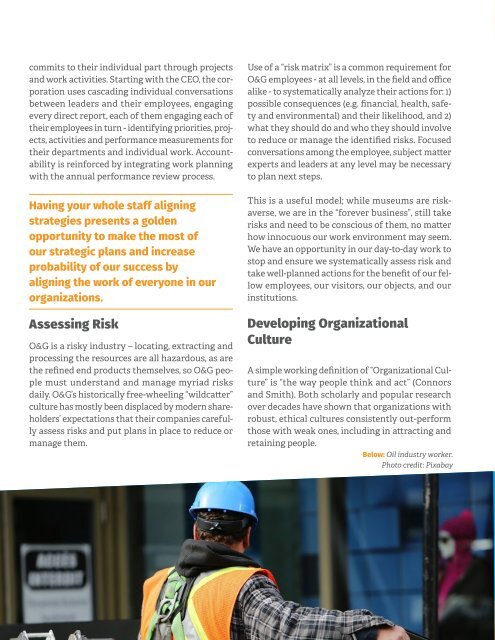Crossing Industries
2015-11-16-roundupIssue263-web-v14
2015-11-16-roundupIssue263-web-v14
You also want an ePaper? Increase the reach of your titles
YUMPU automatically turns print PDFs into web optimized ePapers that Google loves.
commits to their individual part through projects<br />
and work activities. Starting with the CEO, the corporation<br />
uses cascading individual conversations<br />
between leaders and their employees, engaging<br />
every direct report, each of them engaging each of<br />
their employees in turn - identifying priorities, projects,<br />
activities and performance measurements for<br />
their departments and individual work. Accountability<br />
is reinforced by integrating work planning<br />
with the annual performance review process.<br />
Use of a “risk matrix” is a common requirement for<br />
O&G employees - at all levels, in the field and office<br />
alike - to systematically analyze their actions for: 1)<br />
possible consequences (e.g. financial, health, safety<br />
and environmental) and their likelihood, and 2)<br />
what they should do and who they should involve<br />
to reduce or manage the identified risks. Focused<br />
conversations among the employee, subject matter<br />
experts and leaders at any level may be necessary<br />
to plan next steps.<br />
Having your whole staff aligning<br />
strategies presents a golden<br />
opportunity to make the most of<br />
our strategic plans and increase<br />
probability of our success by<br />
aligning the work of everyone in our<br />
organizations.<br />
Assessing Risk<br />
O&G is a risky industry – locating, extracting and<br />
processing the resources are all hazardous, as are<br />
the refined end products themselves, so O&G people<br />
must understand and manage myriad risks<br />
daily. O&G’s historically free-wheeling “wildcatter”<br />
culture has mostly been displaced by modern shareholders’<br />
expectations that their companies carefully<br />
assess risks and put plans in place to reduce or<br />
manage them.<br />
This is a useful model; while museums are riskaverse,<br />
we are in the “forever business”, still take<br />
risks and need to be conscious of them, no matter<br />
how innocuous our work environment may seem.<br />
We have an opportunity in our day-to-day work to<br />
stop and ensure we systematically assess risk and<br />
take well-planned actions for the benefit of our fellow<br />
employees, our visitors, our objects, and our<br />
institutions.<br />
Developing Organizational<br />
Culture<br />
A simple working definition of “Organizational Culture”<br />
is “the way people think and act” (Connors<br />
and Smith). Both scholarly and popular research<br />
over decades have shown that organizations with<br />
robust, ethical cultures consistently out-perform<br />
those with weak ones, including in attracting and<br />
retaining people.<br />
Below: Oil industry worker.<br />
Photo credit: Pixabay


